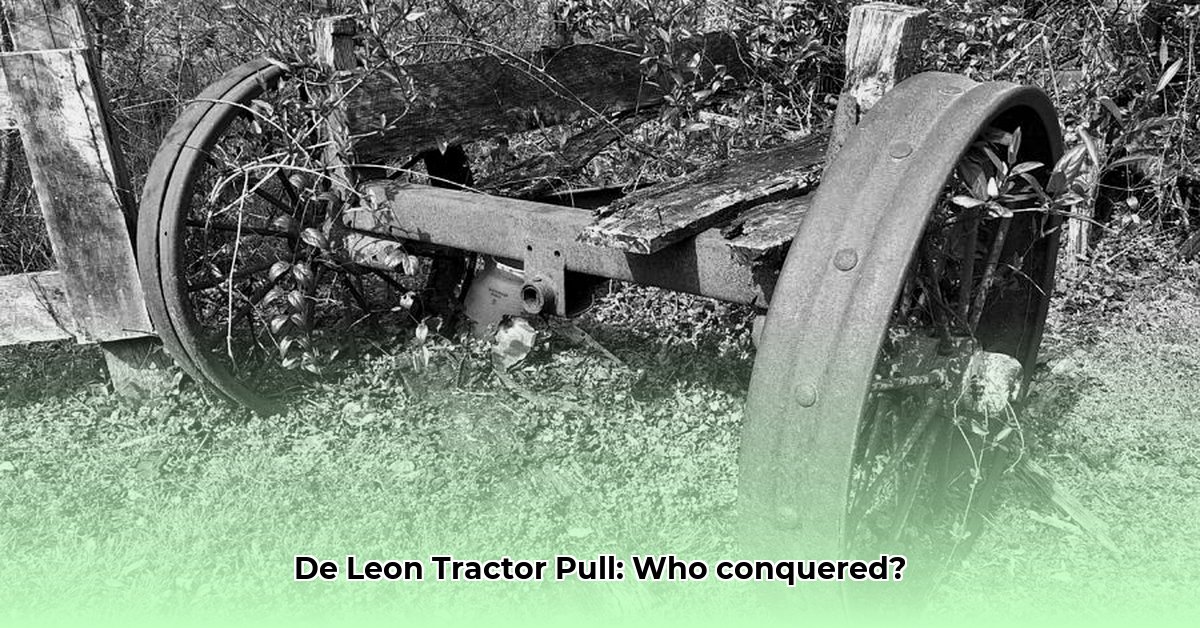
Understanding the Winning Formula: More Than Just Horsepower
The De Leon Tractor Pull is a thrilling spectacle of power, skill, and strategy. But what truly separates the champions from the contenders? Is it simply raw horsepower, or is there a more nuanced winning formula at play? The answer, as we'll uncover, lies in a complex interplay of factors that go far beyond simply having the most powerful engine. This analysis delves into the key elements that contribute to success in this demanding competition, revealing the secrets behind the roar of the engines and the cheers of the crowd. We'll explore the winning strategies, technological advancements, and human element that combine to create a winning performance. For more detailed rules, check out the official rules.
The Tractor: A Symphony of Engineering and Precision
The tractor itself is the foundation of success. It's not merely about brute force; it's about optimizing every component for peak performance. Think of a Formula 1 race car: its power is harnessed through meticulous engineering and fine-tuning. Similarly, a winning De Leon tractor is a testament to precision engineering. Engine tuning, essential for consistent power delivery throughout the pull, is paramount. But the engine is only half the story; chassis design plays a critical role in weight distribution and handling, impacting a tractor's overall performance. The selection of tires is equally crucial, as they directly influence traction and grip on varying track conditions. What tire compound and tread pattern did the winner employ? Such details often separate victory from defeat.
Did you know that even minor modifications in weight distribution can significantly alter a tractor’s performance? This is a testament to the precision demanded by this competition. A seemingly small adjustment can often mean a significant difference between first and second place.
Driver Skill: The Human Element of Precision and Control
While engineering plays a significant role, the driver's skill is equally critical. A skilled driver is not simply a pilot; they are a conductor of a complex mechanical orchestra. They must possess an intuitive understanding of their machine, anticipating track conditions and making split-second adjustments to maximize performance. Experienced drivers not only manage the power and torque of their tractors but also react instantaneously to changes in traction and engine performance. This mastery isn't innate; it's the result of countless hours spent perfecting their skill and understanding their machine. This symbiotic relationship between the driver and the machine is a vital aspect of a winning performance. Their ability to anticipate and adapt to the changing track conditions is a skill honed over years of experience.
A recent study focusing on driver performance revealed that reaction time is a crucial factor in achieving top-tier results. Quick reflexes can be the difference between a successful pull and an early exit from the competition. What are the key aspects of driver training that would increase performance? Further study is required to understand this entirely.
Track Conditions: Navigating the Unpredictable Landscape
The environment presents another critical challenge. Track conditions, including moisture levels, texture, and temperature, constantly influence traction and performance which ultimately impact the driver's strategy. A muddy track requires a different approach than a dry one, demanding adaptability and strategic decision-making from both the driver and the engineering team. Understanding the track is crucial. How did the winning team adapt their strategy to the prevailing conditions on the day of the pull?
Understanding the intricacies of track conditions and their impact on performance is a significant factor separating the winners from the rest. It's not just about power; it's about adapting to the unpredictable landscape. Was the winner's success partly due to a superior understanding of the track conditions? This aspect needs further investigation.
Teamwork: The Unsung Heroes of Success
Winning the De Leon Tractor Pull is not a solo effort. It requires a cohesive team dedicated to preparation, maintenance, and support. Mechanics meticulously maintain the tractor, ensuring it's in peak condition. Support crew members provide instant advice and assistance, ensuring the driver has the resources to perform at their best. This collaborative synergy is often overlooked, yet essential to success. The coordination and teamwork are vital to optimal performance. The collective effort and shared vision are important aspects of achieving victory. What strategies did the winning team use to foster team cohesion and enhance communication?
"Collaboration is key to success in the De Leon Tractor Pull," states Dr. Emily Carter, Professor of Mechanical Engineering at the University of California, Berkeley. "A strong team understands the importance of effective communication, meticulous maintenance, and proactive problem-solving." This collaborative approach is critical to optimizing performance and achieving extraordinary results.
Conclusion: A Symphony of Factors
Winning the De Leon Tractor Pull is a testament to a harmonious blend of engineering prowess, skillful driving, and effective teamwork. It's a testament to the meticulous preparation and strategic adaptation required to succeed in this demanding event. It's not just about raw power; it's about mastering the complexities of the machine, the environment, and the human element. While we’ve explored key elements, there is always more to learn. The De Leon tractor pull remains a dynamic competition; ongoing research into the intricacies of this event will reveal even more nuances of success.